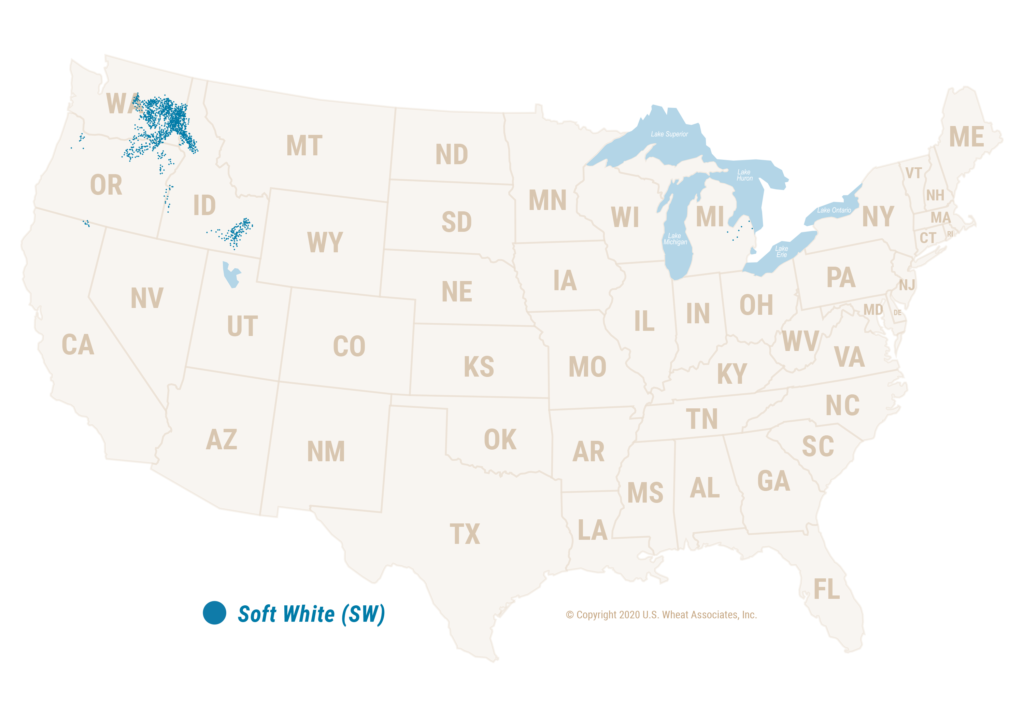2024 soft white wheat crop passes muster
From specialty products such as sponge cakes or Asian noodles to blending with hard red spring wheat for improving bread color, U.S. soft white (SW) wheat flour has the versatility to improve the quality of a wide variety of products. It has a low protein of 8.5% to 10.5% (12% mb), low moisture, and weak gluten. SW includes winter and spring varieties, increasing the protein range and functionality within the class.
As a key part of its commitment to transparency, U.S. Wheat Associates (USW) produces an annual U.S. Crop Quality Report that includes grade, flour, and end-product data for all six U.S. wheat classes. SW was 89% of the wheat production in Washington state in 2024, according to the U.S. Department of Agriculture’s National Agricultural Statistics Service. The following are the highlights from the USW’s SW quality report, originally published in its Wheat Letter Oct. 9, 2024.
New crop soft white production is up; functionality is good
The larger 2024 Pacific Northwest (PNW) SW crop experienced more moisture and moderate temperatures, resulting in typical protein distribution, appropriately weak to medium gluten strength, and acceptable to good functionality. The high protein segment is a blending opportunity for crackers, Asian noodles, steamed breads, flat breads, and pan breads. The club wheat subclass, with very weak gluten strength, is typically used in a Western White blend with SW for cakes and delicate pastries.

Growing Conditions
Ample moisture at seeding helped establish the winter SW crop with moisture and mild temperatures supporting crop growth after dormancy and also supporting spring SW. Those conditions transitioned to a prolonged hot, dry period that stressed spring-seeded crops and accelerated maturity. Yields were average to above average with total 2024 PNW SW production reaching 6.7 million metric tons, 17% more than the 2023 crop.
2024 Highlights
- Average grade for SW and club is U.S. No. 1.
- Test weight averages for SW trended higher this year with a composite average above 60 pounds per bushel. Club test weight was comparable to last year.
- Wheat protein (12% mb) is lower than last year but within a normal range for SW and club.
- Wheat falling number average is greater than 300 seconds and comparable to 2023 and the five-year average for SW and club.
- Buhler Laboratory Mill straight grade extractions, L* values (whiteness), and flour ash are similar to last year for SW. Club straight grade flour extraction and flour ash are down slightly with an L* value similar to last year. Damaged starch trended higher than last year for both SW and club, due to slightly harder kernels. Commercial mills should see better extractions.
- Wet gluten contents for SW flour are lower this year compared to 2023 and the five-year average. This likely reflects higher yields and mild temperatures.
- Solvent Retention Capacity (SRC) lactic acid values for SW are in a normal range for weak to medium gluten strength. Water SRC values are up slightly compared to last year but are comparable to the five-year average for SW. Overall, SW composites have SRC profiles suitable for good cookie and cracker performance. Lactic acid and water SRC values for
club are consistent with very weak gluten with low water-holding capacity. - Starch pasting properties as shown by amylograph and RVA viscosities for SW and club indicate the crop is suitable for batter-based products. The overall SW and club averages are similar to last year’s and the five-year average.
- SW and club show typical dough properties ranging from very weak to medium gluten strength and low water absorption values similar to their respective 2023 and five-year averages.
- Sponge cake volumes for SW are similar to 2023 and the five-year average with softer textures than last year (lower hardness). Club sponge cake volume is slightly smaller than last year and the five-year average with softer texture.
- Average SW and club cookie diameters and spread ratios are significantly larger than last year. These values should not be compared to the five-year averages as the cookie method changed as of 2023.
- Average SW pan bread bake absorptions are in a normal range with specific loaf volumes and scores that trend with protein content and bake absorption. Blends of hard wheat with up to 20% SW should produce acceptable pan breads, especially at the higher end of the SW protein spectrum.
- Chinese southern-type steamed bread specific volumes for SW and club are similar to last year and larger than the five-year average. Product appearance, especially external, was better than last year for both SW and club.
Originally published in the October 9, 2024 U.S. Wheat Wheat Letter also published in the November 2024 issue of Wheat Life Magazine
